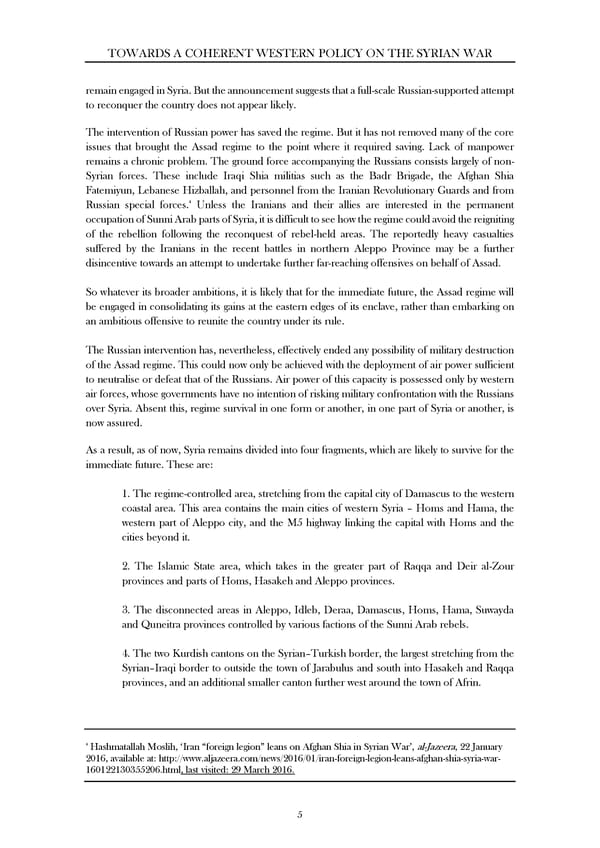TOWARDS A COHERENT WESTERN POLICY ON THE SYRIAN WAR remain engaged in Syria. But the announcement suggests that a full-scale Russian-supported attempt to reconquer the country does not appear likely. The intervention of Russian power has saved the regime. But it has not removed many of the core issues that brought the Assad regime to the point where it required saving. Lack of manpower remains a chronic problem. The ground force accompanying the Russians consists largely of non- Syrian forces. These include Iraqi Shia militias such as the Badr Brigade, the Afghan Shia Fatemiyun, Lebanese Hizballah, and personnel from the Iranian Revolutionary Guards and from 4 Russian special forces. Unless the Iranians and their allies are interested in the permanent occupation of Sunni Arab parts of Syria, it is difficult to see how the regime could avoid the reigniting of the rebellion following the reconquest of rebel-held areas. The reportedly heavy casualties suffered by the Iranians in the recent battles in northern Aleppo Province may be a further disincentive towards an attempt to undertake further far-reaching offensives on behalf of Assad. So whatever its broader ambitions, it is likely that for the immediate future, the Assad regime will be engaged in consolidating its gains at the eastern edges of its enclave, rather than embarking on an ambitious offensive to reunite the country under its rule. The Russian intervention has, nevertheless, effectively ended any possibility of military destruction of the Assad regime. This could now only be achieved with the deployment of air power sufficient to neutralise or defeat that of the Russians. Air power of this capacity is possessed only by western air forces, whose governments have no intention of risking military confrontation with the Russians over Syria. Absent this, regime survival in one form or another, in one part of Syria or another, is now assured. As a result, as of now, Syria remains divided into four fragments, which are likely to survive for the immediate future. These are: 1. The regime-controlled area, stretching from the capital city of Damascus to the western coastal area. This area contains the main cities of western Syria – Homs and Hama, the western part of Aleppo city, and the M5 highway linking the capital with Homs and the cities beyond it. 2. The Islamic State area, which takes in the greater part of Raqqa and Deir al-Zour provinces and parts of Homs, Hasakeh and Aleppo provinces. 3. The disconnected areas in Aleppo, Idleb, Deraa, Damascus, Homs, Hama, Suwayda and Quneitra provinces controlled by various factions of the Sunni Arab rebels. 4. The two Kurdish cantons on the Syrian–Turkish border, the largest stretching from the Syrian–Iraqi border to outside the town of Jarabulus and south into Hasakeh and Raqqa provinces, and an additional smaller canton further west around the town of Afrin. 4 Hashmatallah Moslih, ‘Iran “foreign legion” leans on Afghan Shia in Syrian War’, al-Jazeera, 22 January 2016, available at: http://www.aljazeera.com/news/2016/01/iran-foreign-legion-leans-afghan-shia-syria-war- 160122130355206.html, last visited: 29 March 2016. 5
 Towards A Coherent Policy On The Syrian War Page 6 Page 8
Towards A Coherent Policy On The Syrian War Page 6 Page 8